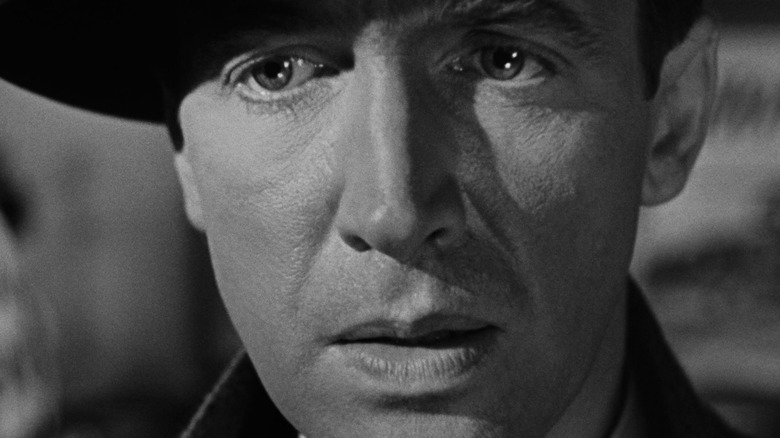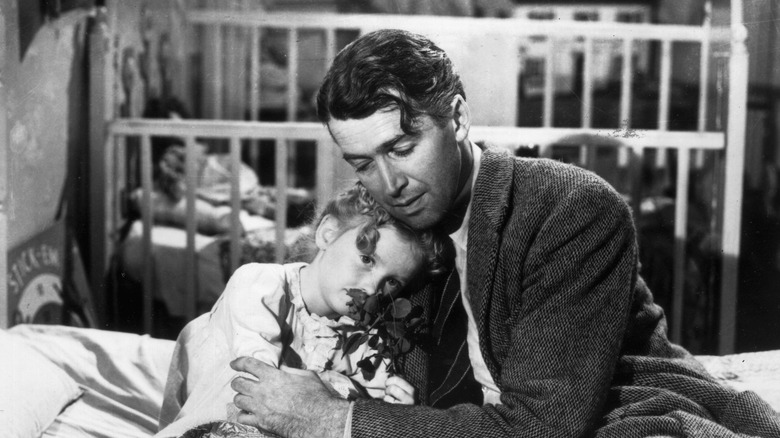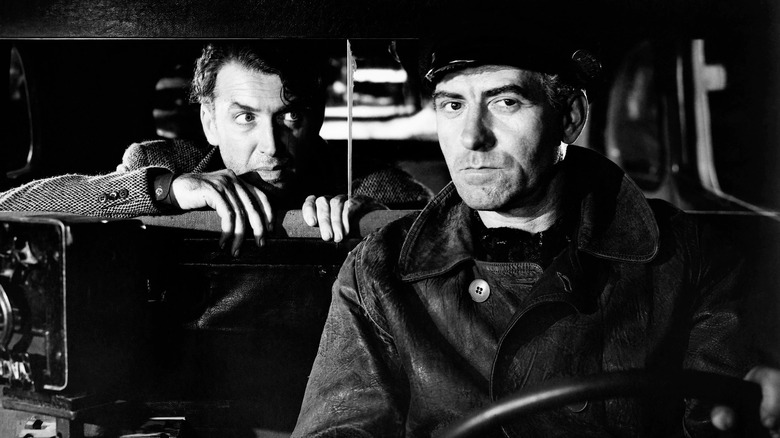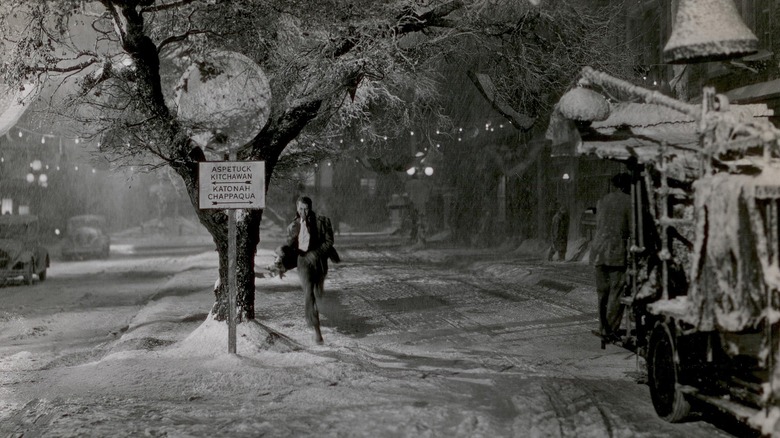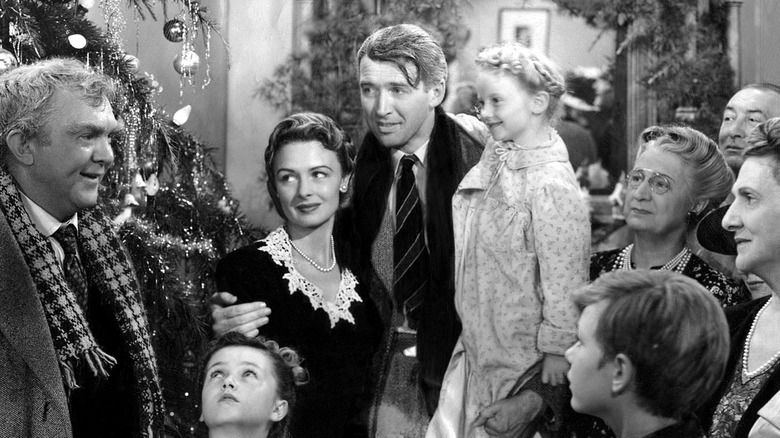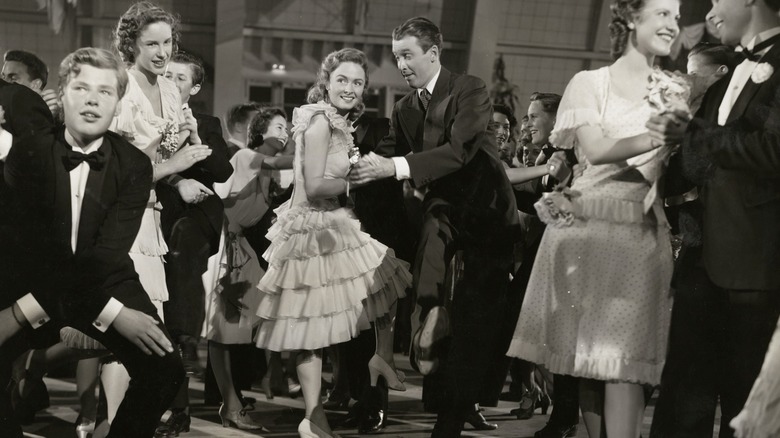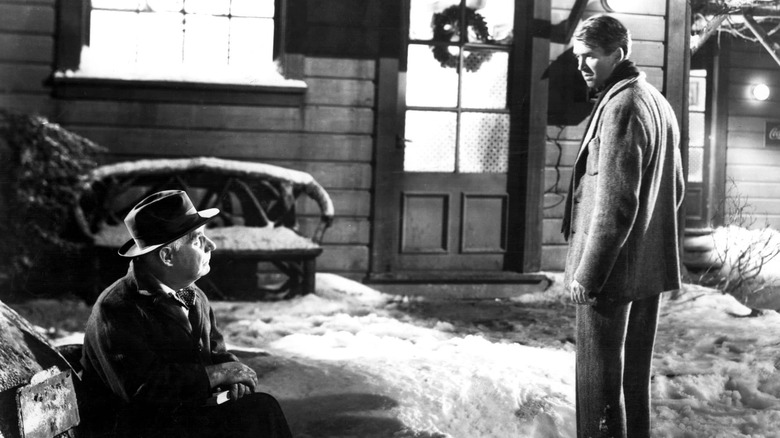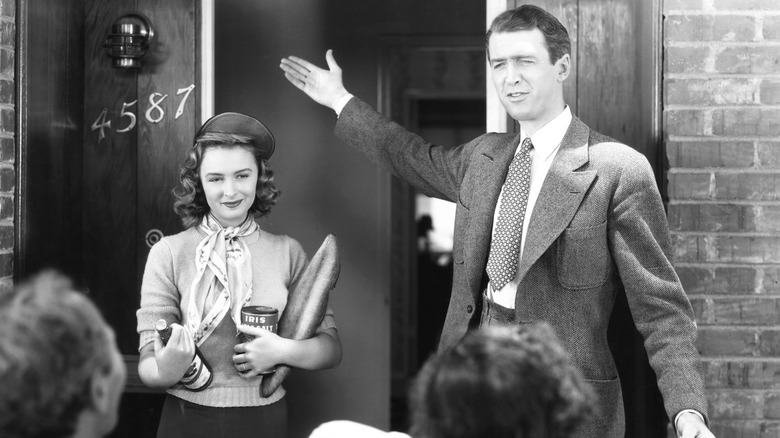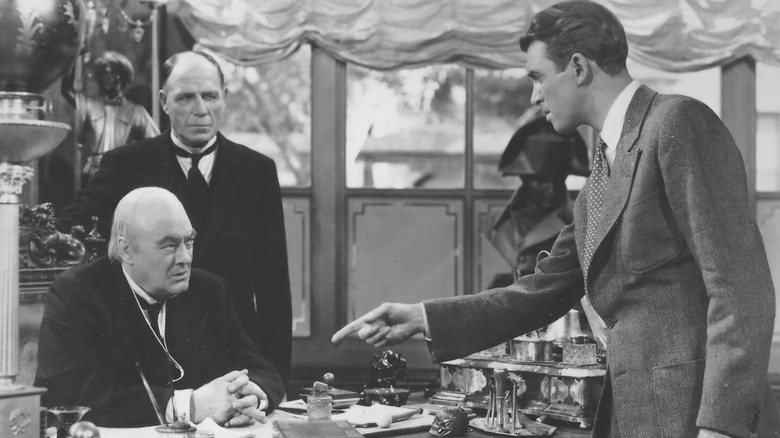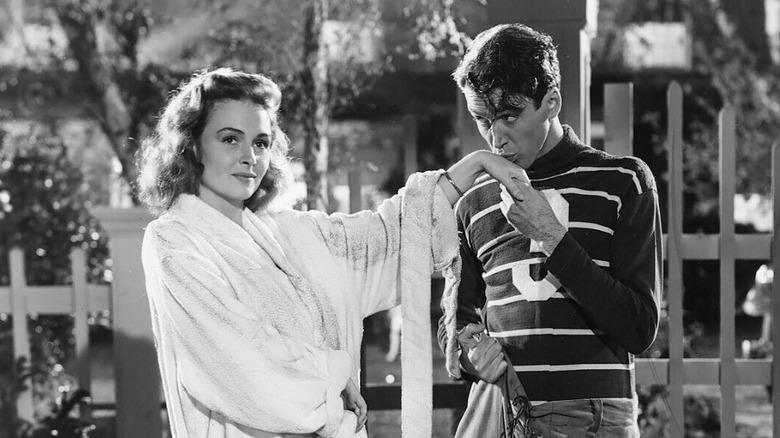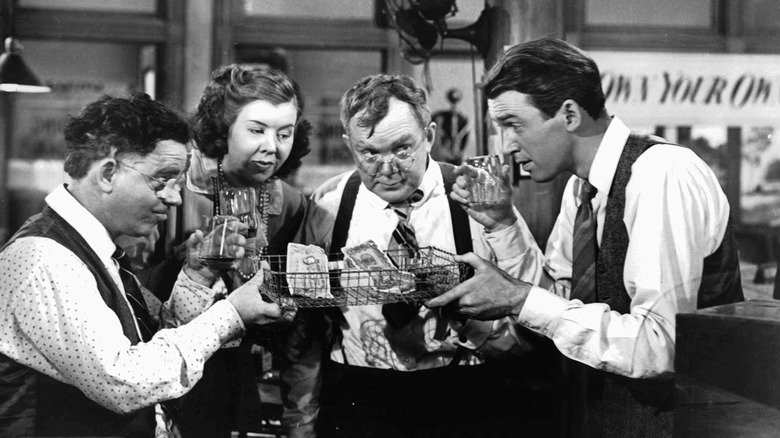Facts Only True Fans Of It's A Wonderful Life Would Know
When it comes to the holiday season, few films capture the wholesome spirit of the most wonderful time of the year quite like Frank Capra's 1946 classic "It's a Wonderful Life." The film has gone down in movie history as one of the all-time greats — but unlike most revered films of the first half of the 20th century, it carries an intrinsic excuse to be rediscovered every year; it is part of the annual Christmastime traditions of countless families. According to the American Film Institute, "It's a Wonderful Life" is considered one of the top 100 movies ever made, ranking at spot number 20, between 1954's "On the Waterfront" and 1974's "Chinatown."
"It's a Wonderful Life" tells the oft-tragic tale of a man named George Bailey who, when pushed to his limits one fateful evening, is on the verge of throwing his life away. But it's Christmas Eve, and a tender intervention by a guardian angel is determined to drive home the message that no life is wasted so long as it has yielded friends, love and community.
By the mid '40s, writer/director Frank Capra had already made a name for himself. Films like "It Happened One Night," "You Can't Take It With You," and "Mr. Smith Goes to Washington" (also with James Stewart) had earned him a reputation as a heartfelt, sincere observer of human behavior. "It's a Wonderful Life" was originally a commercial disappointment, leading to its copyright lapse, newfound status as a public domain darling, and eventual rediscovery as a royalty-free holiday staple for TV stations.
The sentimental Christmas classic has since become the most enduring example of a unique filmography frequently that coined the term "Capra-esque."
It's difficult to imagine a world where "It's a Wonderful Life" was never born; it has become such an iconic part of American popular culture, parodied and referenced constantly, that a classic 1986 "Saturday Night Live" sketch depicted a supposed "lost ending" to the film where George Bailey got revenge on Mr. Potter via angry mob; in 2010, the same show presented a Hanukkah-tinted take; in 2022, another "SNL" sketch" would depict a perverted take on a "Wonderful"-ish distraught man and guardian angel peering creepily through a family's window. How many other films could you imagine warranting parody sketches in 1986, 2010 and 2022, to audiences young and old who would get the joke?
Despite all this recognition, there are still plenty of "Wonderful" facts the average fan doesn't know. So hee-haw, it's time to stop talking her to death, lasso the moon, and appreciate that this is a very interesting situation: It's time to discuss some forgotten facts about the most Capra-esque of holiday classics.
It's based on a short story
While "It's a Wonderful Life" is widely praised today, it's not known for possessing the most original of stories. It shares noticeable similarities to Charles Dickens' "A Christmas Carol" (also the story of a man being shown the error of his ways through supernatural means), but this makes sense — after all, it was based on a short story written with the Dickens classic in mind.
"It's a Wonderful Life" was an adaptation (and re-imagining) of Philip Van Doren Stern's 1943 short story "The Greatest Gift." In Stern's version, the main character is a man named George Pratt, whose attempt to end his life is prevented by a mysterious stranger who shows him how horrible the world would be if he was never born. While it's clearly similar to the film adaptation by Frank Capra, there are some distinct differences — in the book, "The Stranger" is never being explicitly named or stated as an angel, and the backstory for Pratt before his fantastical intervention is barely addressed.
James Stewart suffered from PTSD while filming
When it comes to "It's a Wonderful Life," the performance of James Stewart holds the entire film together. A mix of sincerity and bitterness, wanderlust and despair, it's virtually impossible to imagine any other actor pulling it off so effectively.
Although Stewart gave many all-time great performances (in films like "Vertigo," "The Shop Around the Corner," "Rear Window," "Harvey," "The Man Who Shot Liberty Valance" and more) his kind-hearted, selfless hero of Bedford Falls might just be his best (and according to Time, is one of the best movie dads ever). It may come as a surprise, then, to learn that Stewart was suffering through some serious mental health issues throughout the production, the by-product of his wartime experiences in an age when "PTSD" was still a long way from becoming a commonly-used phrase.
Unlike his character George Bailey, Stewart did serve in the United States Army — as a pilot throughout the Second World War. Unlike many famous actors who joined the war effort, he insisted on frontline service, eventually piloting a B-24 Liberator on several missions over Germany (and earning himself a Distinguished Flying Cross in the process). According to some 2016 revelations by Robert Matzen, author of the book "Mission: Jimmy Stewart and the Fight for Europe," the actor is believed to have been suffering from what was then typically described as being "flak happy" while re-acclimating himself to his old acting career.
"At this point, he had just started to eat again," Matzen explained. "He always had a high metabolism and always had trouble digesting food, and during the war it got worse and worse."
They created a new kind of fake snow
By the 1940s, countless movie productions had utilized fake snow to set their stories in cold climates, despite typically filming in sunny California. The would-be snow most commonly used in those days looked good on camera, but had some serious drawbacks, particularly when it came to sound design. Made largely of corn flakes, when stepped on the snow, it was prohibitively loud — with few exceptions, such scenes had to be reconstructed in post-production, with extensive dubbing and ADR efforts. Some older forms of synthetic snow even used asbestos, which by the mid-1950s would be tied to lung cancer and by the late '80s would be banned by the EPA. It also didn't help matters that the Christmas film would be shooting in June and July.
With all these factors in mind going into production on "It's a Wonderful Life," Capra insisted on finding a new way to make fake snow that looked realistic, was safe, and would be quiet enough to allow the actors to properly record their lines. To achieve this, he reached out to RKO special effects whiz Russell Sherman, who concocted a new mixture out of foamite, water, sugar, and soap flakes. Thanks to their efforts, the film production was able to spray massive amounts of this new, improved artificial snow all over the set with ease. The production team would be rewarded for their ingenuity by receiving the film's only Academy Award, for Technical Achievement, honoring the creation and utilization of their unique snow.
Constant re-runs made it popular
"It's a Wonderful Life" was generally considered a box office flop upon release. It earned five Oscar nominations, but production company Liberty Films wrote off the film as a loss of more than a half million dollars. In essence, it killed the independent production company, founded by Capra and Samuel J. Briskin; Liberty Films only produced two movies, finding itself after "Wonderful Life" on the brink of bank foreclosure, then was sold to Paramount Pictures barely two years after its inception.
As crazy as it may seem in today's media landscape of digital media libraries, cable TV and ancillary sales, there was little reason at the time to assume any movie would earn revenue beyond its release window. So, when the 1909 Copyright Act came into play on the rights for "Wonderful Life" — ending its protection window of 28 years unless the copyright holders renewed their license — then-distributor Republic Pictures failed to extend the copyright. It was the mid-'70s, most people had long forgotten "It's a Wonderful Life," and now the film could be exhibited anywhere, by anybody, as a public domain film. TV channels began airing it ad nauseum around the holidays, and the first of multiple modern generations grew up with the Capra film as a ubiquitous presence on their televisions.
Whereas many critics at the time of the film's release had dismissed as overly sentimental, modern critics found a quaint, heartwarming beauty in their reappraisals.
"The best and worst things that ever happened to 'It's a Wonderful Life' are that it fell out of copyright protection and into the shadowy no-man's-land of the public domain," Roger Ebert said in his four star review. "Because the movie is no longer under copyright, any television station that can get its hands on a print of the movie can show it, at no cost, as often as it wants to... What is remarkable about 'It's a Wonderful Life' is how well it holds up over the years; it's one of those ageless movies, like 'Casablanca' or 'The Third Man,' that improves with age."
For their part, Stewart and Capra both always believed that the film deserved better and cited it as among their best works — thankfully, both lived to see the early years of its reemergence. "It's the damnedest thing I've ever seen," Capra said to the Wall Street Journal in 1984. "The film has a life of its own now and I can look at it like I had nothing to do with it."
The High School gym with a pool underneath is real
One of the most memorable scenes from "It's a Wonderful Life" has George laying eyes on a grown-up Mary (Donna Reed) for the first time, then participating in a Charleston competition (a dance that became a national sensation during the roaring '20s) that goes haywire when Mary's scorned date (Carl Switzer, the iconic Alfalfa from "The Little Rascals") makes the mechanical dance floor open up to a giant pool below. Believe it or not, that part of the gym was real — and it's still there.
Beverly Hills High School in California is the real-life location where the cast and crew of "It's a Wonderful Life" filmed the scene. According to the school's official site, their historic "Swim-Gym" is still very much in use. "The Swim-Gym has been featured in many movies," reads the site, "including the classic 'It's a Wonderful Life'. It is still enjoyed today by Beverly Hills High School students and the residents of the community." Other notable, albeit much more recent, productions filmed at the high school include "Clueless," "Whatever It Takes," and "Real Women Have Curves."
It was Frank Capra's favorite movie that he made
Capra was among a generation of great directors whose careers soared in a post-Depression film landscape; his contemporaries included names like John Huston, Ernst Lubitsch, Preston Sturges and Orson Wells.
An Italian immigrant who rose to Hollywood prominence, films like "It Happened One Night" and "Mr. Smith Goes to Washington" touched on what it meant to be an American; at a time in and around World War II, such messaging hit home. Out of all his films, however, he always saw "It's a Wonderful Life" as his magnum opus.
"I didn't give a film-clip whether critics hailed or hooted 'Wonderful Life.' I thought it was the greatest film I had ever made. Better yet, I thought it was the greatest film anybody ever made," the Harvard Film Archive quoted Capra as saying. "It wasn't made for the oh-so-bored critics, or the oh-so-jaded literati. It was my kind of film for my kind of people... A film to tell the weary, the disheartened, and the disillusioned; the wino, the junkie, the prostitute; those behind prison walls and those behind Iron Curtains, that no man is a failure.'
"I wanted to shout, 'You are the salt of the earth," he continued. "And 'It's a Wonderful Life' is my memorial to you."
It's one of the most inspirational movies ever
Not only is "It's a Wonderful Life" a staple of the holiday season, it also has become regarded as one of the most inspirational movies ever made. Since it is focused on the trials and tribulations of a lovable everyman like George Bailey, generations of audiences have been able to connect with the story.
The American Film Institute listed "It's a Wonderful Life" as the number one most inspirational American film ever made, beating such other notable contenders as "To Kill a Mockingbird," "Schindler's List," "Rocky," and the Capra/Stewart production "Mr. Smith Goes to Washington."
It's important to note how this movie has been inspirational not only to audiences, but to other filmmakers as well. Several of the biggest names in Hollywood have frequently cited "It's a Wonderful Life" as one of their favorite movies of all time. Directors such as Steven Spielberg, Frank Darabont, David Lynch, and Akira Kurosawa have all sung the film's praises over the years. Orson Welles, known for being a tough critic, even once said: "There's no way of hating that movie."
Mr. Burns from The Simpsons is somewhat based on Mr. Potter
"It's a Wonderful Life" has left a huge cultural footprint in the nearly 80 years since the film was released; as a result, it has led other creators to respectfully recycle certain plot elements.
Each character in Capra's film fills a very specific role, none more so than Mr. Potter (Lionel Barrymore, grand-uncle of Drew Barrymore), the diabolically dedicated villain constantly trying to destroy the Bailey family building and loan, one of the last means of opposition in Bedford Falls. At a key point in the film, he even stoops so low as to steal $8,000 in cash from poor, hapless Uncle Billy (Thomas Mitchell).
Unlike miserly characters such as Ebenezer Scrooge, Mr. Potter never redeems himself in any way, not even by the film's end. In fact, it seems unlikely he would ever want to undergo any change of heart at all, since he had plenty of chances to be honest with George Bailey about the missing money.
Which may be why legendary cartoonist Matt Groening looked to Mr. Potter as an inspiration for Springfield's greediest (and most fragile) resident, Mr. Burns in "The Simpsons." According to an old TV Guide piece back in 2000, Groening confirmed that the two biggest models in the development of Mr. Burns were Mr. Potter and John D. Rockefeller.
Many famous writers worked on the script
The story of how "It's a Wonderful Life" went from a mostly unknown short story to a worldwide Christmas classic is a complicated one. It had been in the works for a long time before Capra ever got directly involved, and attempts to draft the perfect script had been arduous. Some of the biggest screenwriters in Hollywood at the time took passes at the story at various stages of its creation, to varying degrees of success.
One of the biggest names to tackle "It's a Wonderful Life" was Dalton Trumbo, an award-winning writer who created the scripts for films like "Roman Holiday," "Spartacus," and "Thirty Seconds Over Tokyo" to name a few. He was notoriously blacklisted by the House of Un-American Activities Committee for supposed communist sympathies during the Red Scare; in his version of "It's a Wonderful Life," George Bailey was a politician who gets a glimpse of what life would be like if he abandoned his principles for wealth. Beloved poet Dorothy Parker also touched up the script later; it's unclear to what extent her biting wit made it into the final product.
It was accused of being communist
The 1940s and '50s weren't the best time in American history to voice political opinions outside the norm. As the United States became increasingly committed to a Cold War with the U.S.S.R., culture at home became staunchly anti-communist. Hollywood, in particular, suffered a drastic period of witch hunting called the Red Scare, where artists suspected (with or without cause) of communist sympathies could see their careers destroyed. While Capra was never blacklisted, his most famous film underwent some unwarranted scrutiny at the time, as people within the FBI became suspicious over its disapproving view of unrepentant capitalism.
"[The film] deliberately maligned the upper class attempting to show that people who had money were mean and despicable characters," one FBI document from the time read. Under control of director J. Edgar Hoover, the FBI released a memo about the film, with the unnamed FBI author saying "those responsible for making 'It's a Wonderful Life' had employed two common tricks used by Communists to inject propaganda into the film," with the tricks supposedly being the smearing of so-called American values and glorifying communist ideals, both in the Mr. Potter-vs-the-common-man storyline.
What's ironic was that Capra was not only not a communist, but quite the opposite. Capra was a big believer in the U.S. being a land of opportunity, and according to the History Collection, was a Republican and a conservative. The further irony is that the FBI didn't realize that Albert Maltz, Michael Wilson and Trumbo all performed uncredited writing work on "It's a Wonderful Life"; if they had, the smoke might have become a fire, as the three men would later become members of the Hollywood Ten, banned from the industry for being actual Communist Party members and supposed sympathizers.
